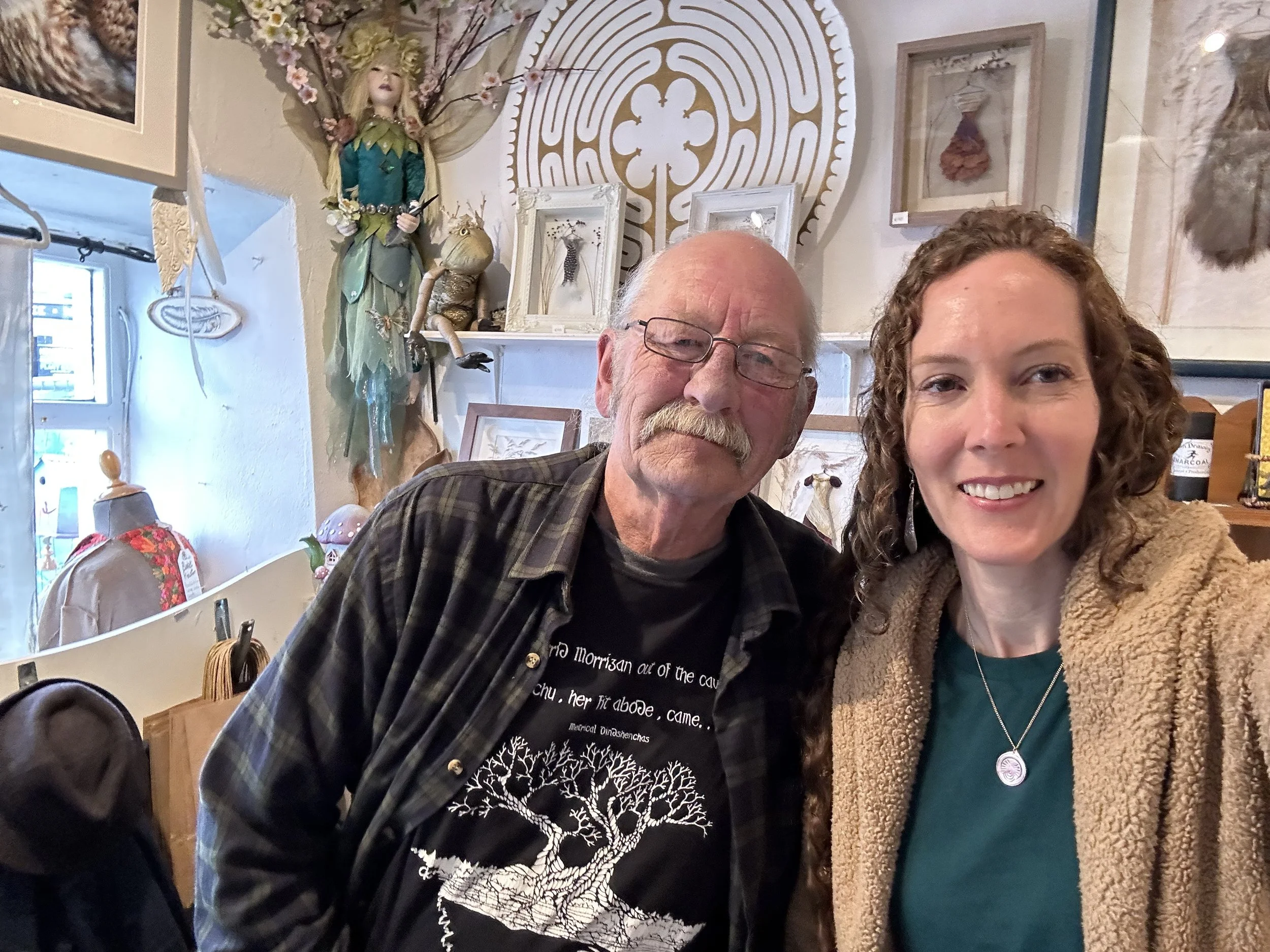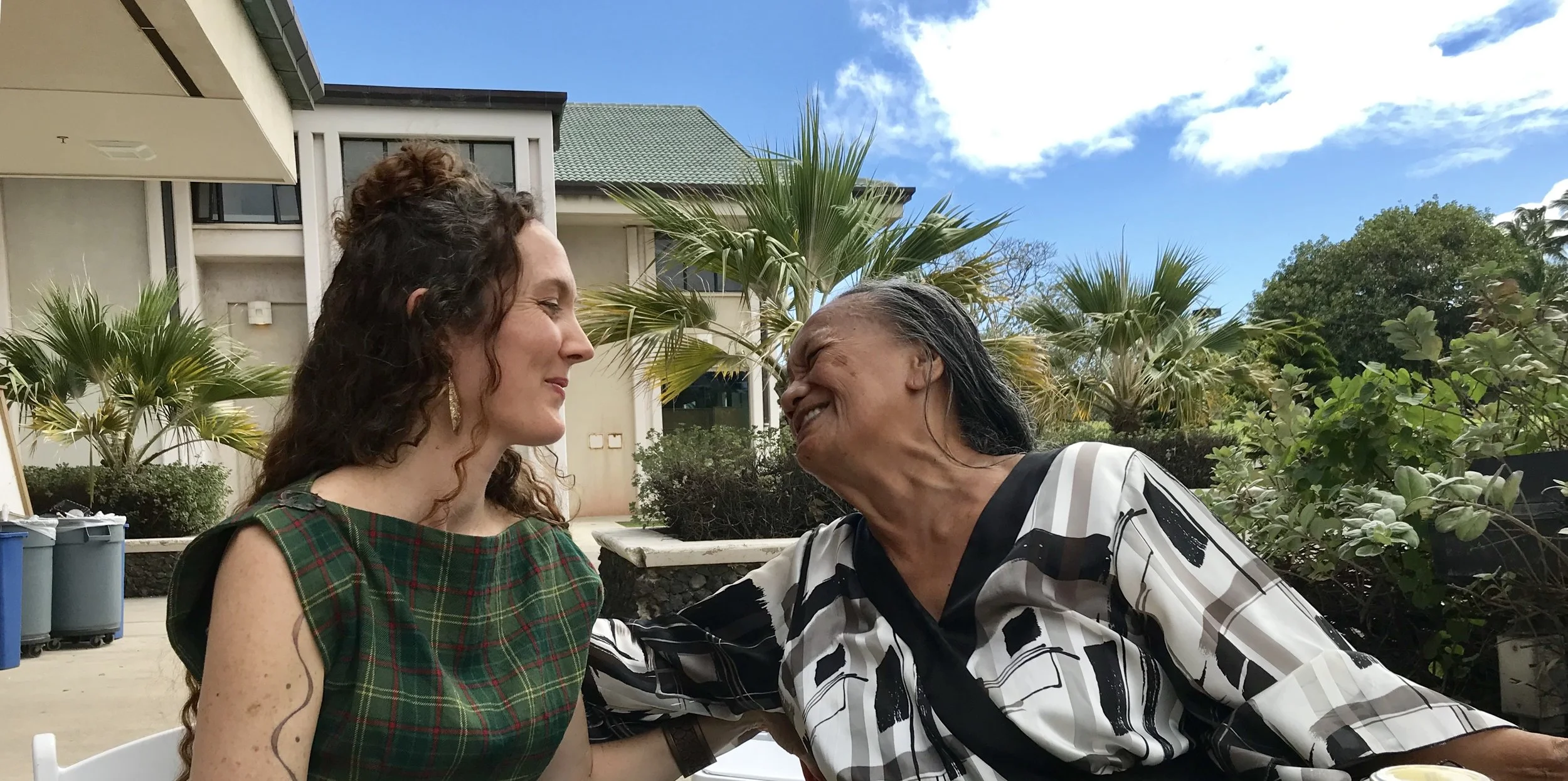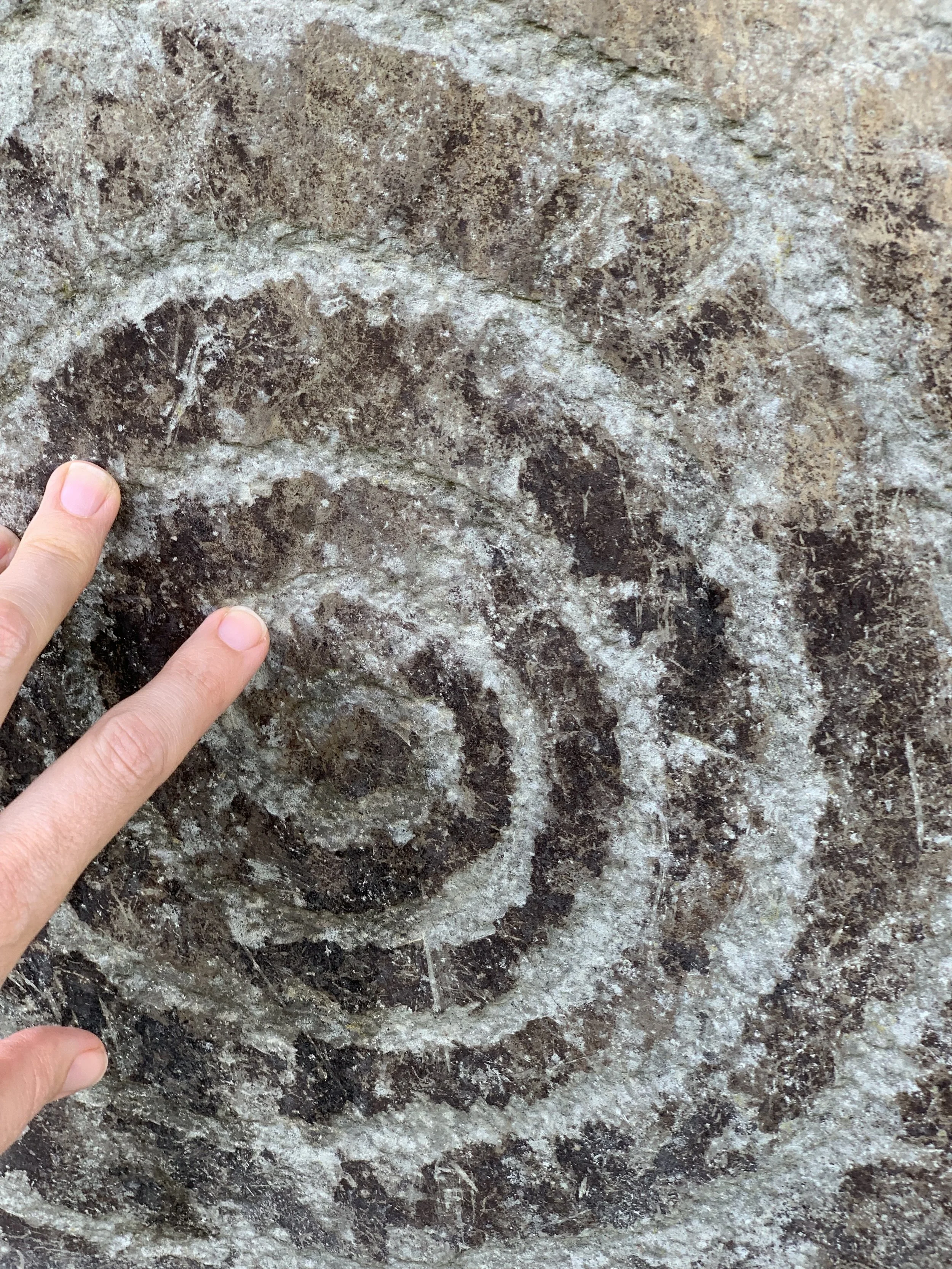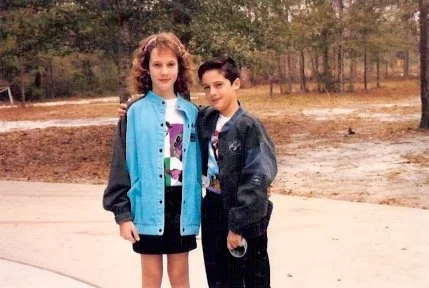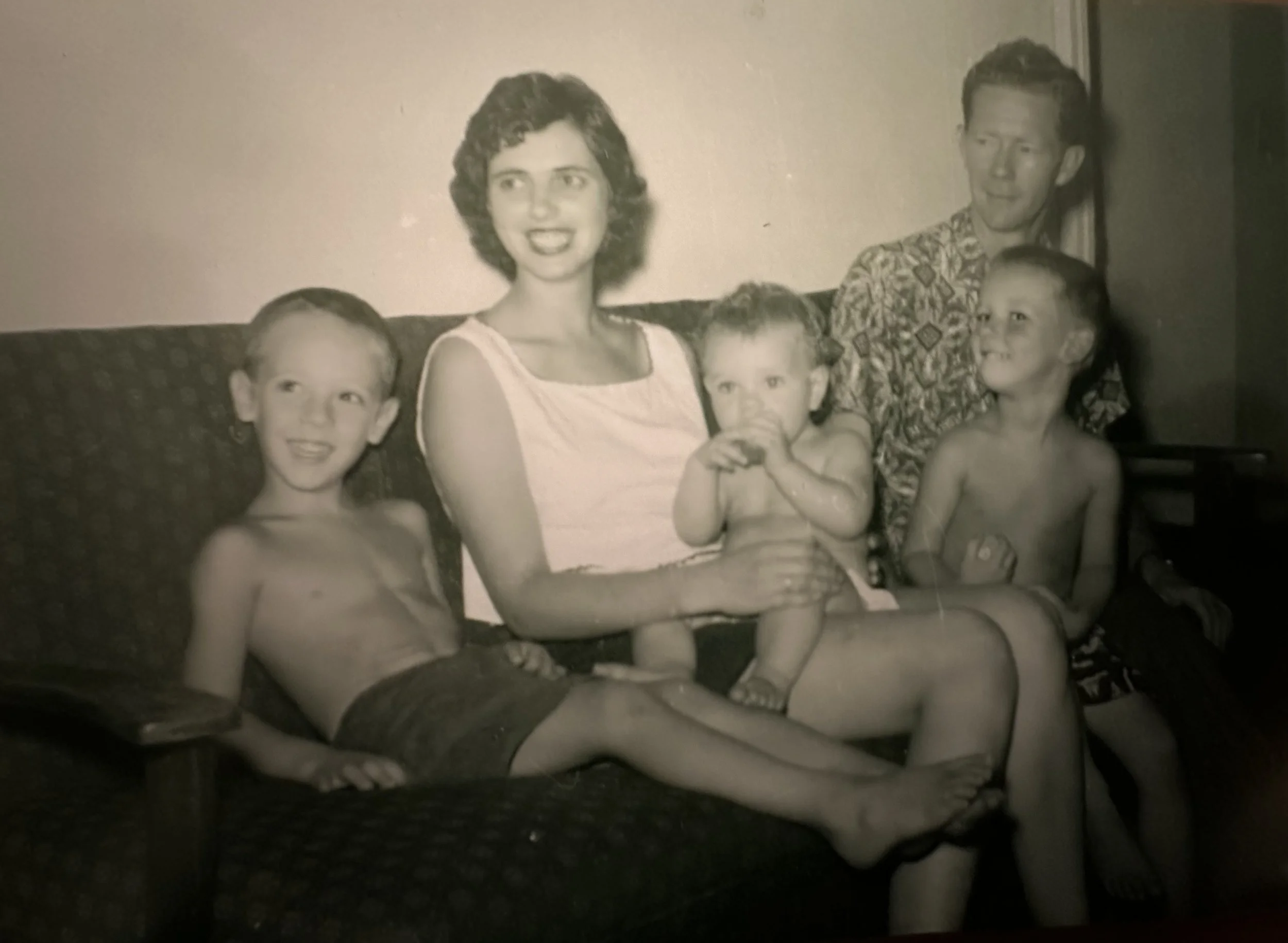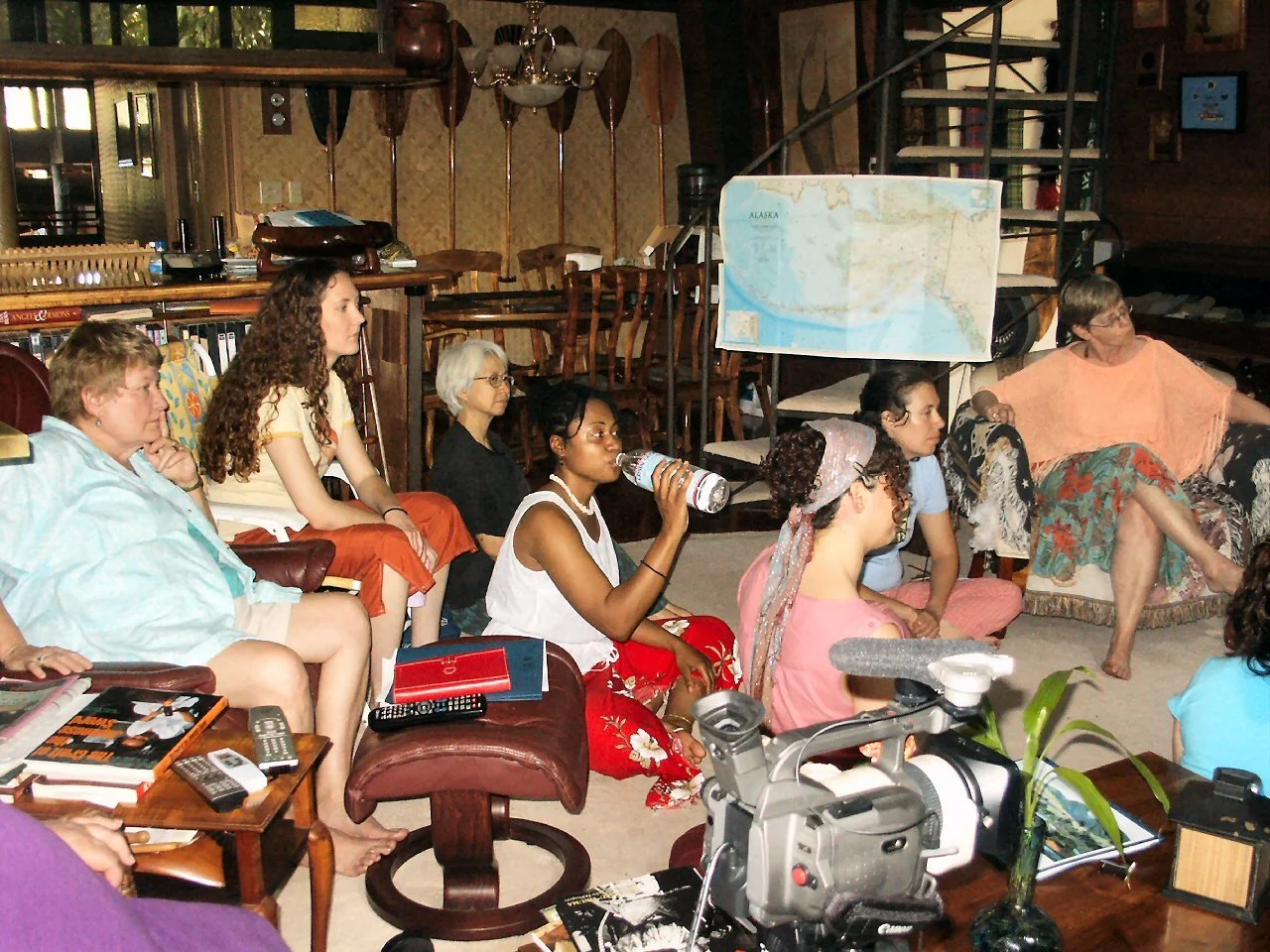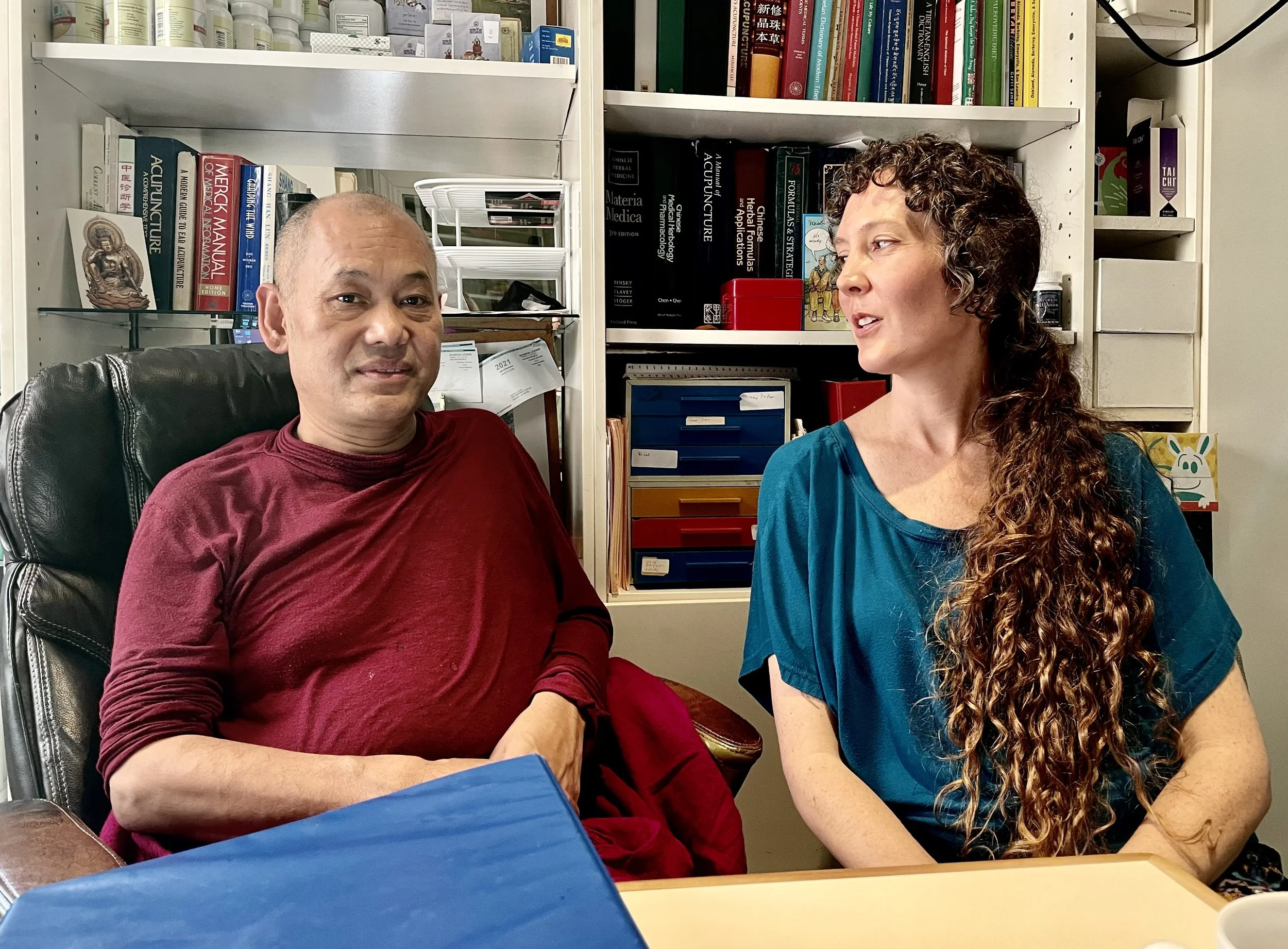in my Tibetan dress, 2025 | photo by Darren Gibbs
The following story comes from the land, which wants us to know we are whole. Occoneechi Mountain asked me to don my regalia to tell this story. I went to retrieve my usual dress—the peplos-style tartan of County Armagh that brings together my Gaelic clans from Ireland and Scotland, and the migrations preceding them—but the mountain clarified, "not that regalia." I needed to put on my Tibetan chupa, which I’d never been able to wear. Two chupas have come to me through the Tibetan monastic community, and have sat in my closet for years.
Alive on its own terms, regalia symbolizes kinship and alignment. Ceremonial attire draws the spirit of the land and ancestors forward to speak and act in integrity for all beings—meaning all beings in all realms throughout all times. Until recently, I could not wear my chupa, nor the beautiful ancient symbol on the pendant that my dear, late friend Jack Roberts made, because both required an integrity I had not yet discovered. Whenever I’d wear the pendant (the symbol for Ireland’s life-sustaining white cow goddess Boann), I’d encounter predatory negativity. Only in retrospect do I understand that the symbol was showing me my own unintegrated conflict. The dress acknowledges my community ties with Tibetan people and commitment to dharma. Dharma means the direct expression of reality’s natural state—becoming unconditional love in a human body.
with Jack Roberts in his shop in Galway, 2023 | photo by Erin Langley
It’s not that the chupa itself or the necklace are a big deal, but that wearing them signified completion. I had just passed a test—one I’ve failed for lifetimes. Finally, “I” had surrendered. I lay there in the physical and symbolic darkness, literally weeping on and off for weeks, letting love completely digest me. I learned that integrity means more than our actions; it includes our thoughts and energy behind closed doors. My dreams showed me symbols to indicate where I was in the process, and told me how to focus my energy. It felt awful, no different than being eaten by an animal. While passing this test marks a passage from which “I” cannot return, it is not a one-and-done. Now the mountain’s dream of wholeness becomes stabilized through continuous expression of aligned activity and ritual action within the community. “Staying dead'“ requires a complete shift in perspective that must be continuously cultivated.
with Kupuna Auntie Maille Shaw, grand daughter of Alice Kaehukai Shaw Kaae (1867-1956), the last traditional guardian of Mokuhinia, at a cultural gathering for the Indigenous peoples of Polynesia, 2019 | photo by Venus Herbito
This story is not about me, but about how the land speaks through human beings. Since I’m donning regalia, I won’t emphasize the thousands of hours I play Royal Match, or the time I watched a full season of Love is Blind. A bunch of cussing and Diet Coke is in there, too. A checkered past, lurid tales of mischief—I leave nothing out. Alignment has nothing to do with perfection or improvement or striving for anything at all. It means honesty and surrender to the cohesion of the collaborative now.
Initiation deeply unsettles what is not love, exorcizing everything that impedes belonging. It is eviscerating and chaotic. In Chinese iconography, Zhang Dao Ling rides a Tiger because he is OK with being out of control. Feral forces cannot unseat him. It’s not that life becomes comfortable, but that there’s just the one seat, and it happens to be on a Tiger. Full disclosure, the chupa got uncomfortable, and I wrote most of this in my underwear.
Tribal Identity
Hill of Tara, 2023 | photo by Fabrice Jolivet
My ancestors are Anglo-Saxon, Gael, Celt, Ashkenazi, Frank, Germanic, and the Indigenous peoples of Anatolia, the Caucasus caves, and Eurasian steppe. We migrated from the Pontic Steppe to the Black Sea and Anatolia, then into the Mediterranean as the Nuragic mound builders, before making our way into continental Europe and the British Isles, then into the northeastern parts of Turtle Island on my mom’s side, and the Southeast on my dad’s. I grew up on Timacua, Yamasee, and Seminole land (Middleburg, FL), then spent nearly 20 years in the Ohlone territory of the Huchuin band of the Confederated Villages of Lisjan (Oakland, CA). Now I tend the ancestral lands of the Yésah (“the people”), including Eno, Monacan, Shakori, Tutelo, Sissapahaw, Saponi, and Occaneechi tribes (Chapel Hill, NC) with my husband and two kids.
View
Land, ancestors, and community come before me because I don’t exist apart from them. It took me years to be able to introduce myself in a traditional way—long enough to upend the worldview that says I’m separate. I was born to a society that told me I’m a meat-suit in a hierarchy of hunger. I felt like I had to choose between a salvational outlook or a scientific one, and later learned these two incomplete views share the same set of assumptions: We’re discrete and incomplete; there’s a self and an other, a beginning and an end, and that we’re going somewhere. Wherever “there” is will be better that here and now, especially if we try really hard.
In the salvational worldview, linear thinking shows up as self-improvement, transcendence, hope, and healing. I especially dislike hope because it means I wish things were different from how they are, and I don’t. I love making dynamic use of any auspice, including extreme adversity. Inspired action is always available—even in a coma. I shy away from “healing” because it implies a destination, the possibility of being fixed, or a need to be saved.
spiral petroglyph at Cnogba (Knowth, kerbstone 5), 2019 | photo by Erin Langley
Mainstream science presumes linear ascent through evolution. Most people think evolution means upward mobility and improvement, rather than adaptive improvisation emerging from cyclical patterns. Earth does not try to be good, much less better.
We’re all doing our best, and the English language doesn’t make it easy. We can’t leave the world of nouns, of divide and conquer, of separation from nature. But even something as fundamental as linguistic structure cannot undermine wholeness for very long. Love is not a fashionable word, nor exactly adequate to describe our basic nature. Nondual love is baked into most indigenous language, law, and ceremonial structures; people enact it in as many ways as there are lands. Kinship is not a concept. English thinks anything can be discussed, which demonstrates our baseline dissociation. Non-duality needs to be danced, sung, painted, played, laughed, and wordlessly or ritually enacted.
Twenty years ago, my colleagues and I called this messy surrender “losing our western minds.” Some might call it losing our modern minds, but I don’t want to preclude the west or modernity from remembering who we are. Entering our whole mind simply means being composted by love beyond conditions. With our small, separate selves reluctantly goes Descartes, the grandfather of dissociative rigor that so many of us have internalized. Hating our heritage and disowning humanity for our violent forgetting make logical sense, but not embodied sense. Ideas are only worthy if they don’t come between us and Earth.
Maui, 2005: the chanting of genealogy between Aunti Mahalani Poe Poe and a local Hawaiian chief to receive permission to enter his land
Wholeness has always been here, and now it’s dreaming human beings toward a new era of belonging. We tend lands that our ancestors may have not seen for millennia, or even set foot on. What does it mean to become human together—not just with the people we agree with—but with our actual neighbors? The land is in charge of that. Our indigenous mind sings us forward, surrendering to synchronicity and allowing us to be dreamed forward by the collaborative powers that put us here.
me with Occaneechi elder and culture keeper Beverly Payne, and Occaneechi historian and storyteller Lawrence Dunmore III on the site of an ancient Occaneechi village in Hillsborough, NC | photo by Erin Langley
In April of 2023, almost a full year after arriving in Chapel Hill, I realized I’d never formally introduced myself to the land or made offerings to its descendants. I’d just facilitated an Ancestral Remembrance gathering on Zoom, and thought to myself, “If I were the ancestors of this land, I would hang out at the reconstructed Occaneechi Village.” So, I hopped in my car and headed over to the Eno River. When I arrived, the village was filled with living Occaneechi people in full regalia. In awe, I asked, “Are you always here?” Elder Beverly Payne replied, “No—just today. We’re rededicating the village.” I introduced myself in a traditional way, and later made offerings to the tribal council, amazed that the land had orchestrated this ancient exchange.
Hawaiian Kahuna and elder of the Indigenous Mind program, Hale Kealohalani Makua | photographer unknown
Roots have little to do with privilege, pedigree, and paper trails. We enact our ancestors. When we align with the spirit of the land, the natural process of ancestral resolution and artfulness happens through us. We greet circumstances and synchronicities that arise as agents of wholeness, often painful and disorienting. This is excellent. Surrender to confusion as a fertile threshold.
There is no starting point that we are moving toward or away from. Roots foster continuity and belonging with the people and lands who love us, and hold us accountable to our relationships, including nonhuman relatives and past and future generations. When I remember who I am, I am surrounded by family even when “I’m” “alone”—concepts that evaporate in our indigenous minds.
Wholeness confers the revelation of relationship. Late Hawaiian Kahuna Hale Kealohalani Makua could chant his genealogy back to his original star system. It’s not just unbroken oral tradition, but the intrinsic knowing that comes with intimacy. Sometimes our indigenous ancestors deliberately left information out of oral lore to protect and preserve culture, and to give future generations the joy of revelation. Sometimes elders deliberately mislead us as trickster agents of awakening, ousting us from duality’s trap of guru adoration. Non-dual love and the spirit of the land can then fully initiate us, completing cultural transmission to unfold at nature’s pace. Earth renews itself through groups of listening people. Anywhere we gather in unconditional love, that’s what’s happening—even when we have no idea what we’re doing, even if it’s “just a book club.”
Upbringing
my family, 1988 | photo by Kimali Lynn
Like most of us, I was born to a time and place of profound forgetting with the clear, bright task of becoming love in a human body. In the spirit world, non-dual love is our baseline state—a non-event. But in a body, it doesn’t go smoothly. And that’s on purpose. I imagine the enthusiasm of our pre-incarnate essence saying to ourselves: “Let’s see you love your way through hell!” right before we’re crushed face first through a meat-vice into a cold, sterile hospital room on planet Earth. Untested love is incomplete love.
My parents named me Erin. They didn’t knowingly name me for the sovereignty goddess who gave Ireland its name, but that is what happened. (And no, I’m not on a goddess trip.) Erin means “fertile land” and “Ireland.” Langley means “long meadow” or “from England.” As this pairing suggests, intrapersonal war has characterized much of my life. It took me 45 years to lay down arms.
me and my brother in Billabong jackets, 1991 | photo by Judy Langley
Growing up, my mom worked in the beauty industry as a nail tech. I spent long afternoons in the salon after school, roaming the shopping center with primordial longing. When I was 11, she brought our whole family to a beauty expo in Orlando that included a drag show. I’d never heard of drag queens, but as soon as these radiant, off-script beings took the stage, I knew I could live in this world. I stood right in front of the giant speaker as EMF’s “You’re Unbelievable” thundered through me. I wanted to stay forever.
My mom went on to graduate from the Barbara Brennan School of Healing. Her enormous love keeps our family whole. When my brother nearly died in a dirt bike accident, she yelled at the priest (who’d come to administer last rites) to leave. Instead, she put her hands on my brother, and he recovered. I fought with my mom for way too long before realizing she’s the ride-or-die of my lineage, who took on significant negativity so that my brother and I (and our children) can live more freely. And we do. The only way to adequately thank her is to carry her deep love forward in my own family and for all beings.
my grandparents Eleanor and Jim Langley with their three boys around 1962 | photographer unknown
My dad installed cabinets and countertops for years before starting his own business. My dad’s side feels like a straight, narrow sunbeam illuminating my path every day. They’re teachers, preachers, circuit riders, and prohibitionists. They have a faith you could set a box on, which they carried with them on horseback throughout the Southeast. My paternal grandfather died when my dad was only 16, but continued to show up in my Mammaw’s dreams for years afterward to help her raise their three boys. That’s how reliable my father’s line is. My dad provides. I did not know how lucky I was as a child to have two parents who loved me and plenty of food to eat. My brother takes after my dad. He can build a house with his hands, and makes sure everyone feels cared for.
Coming of Age
Glanum, France 1999 | photographer unknown
When I was a teenager, I started having visions, precognitive dreams, and out-of-body experiences. Visions are like seeing through closed eyelids. Out-of-body experiences bring me to other worlds that often feel more real than this one. I enter them not from sleep, but from waking. Paralysis pins me down, then a buzzing whoosh whisks me god-knows-where, whether I want to go or not. Seers can become mirrors that invite clear seeing, as long as we keep the mirror polished through the discipline of love.
Black Sea by Erin Langley, acrylic and oil pastel on paper, based on an out-of-body experience, 2005
I had no idea that “mystical experiences” were completely normal. Church didn’t help, and there were no rites of passage. I had no elders, community guidance, view to sustain me, or village to welcome me home. Like many teenagers, I holed up and made art while feeling misunderstood. I cut myself and starved myself to externalize searing pain that perfectly mirrors the ways we collectively starve and assault nature, including human nature.
with the Black Madonna pilgrims in Mt. St. Baume, France, 1999 | photographer unknown
I studied art briefly at the University of Florida, then for one week at Atelier Marchutz in Aix-en-Provence, France before dropping out. Instead of going to class, I hitchhiked to Mt. Sainte-Baume, the final resting place of Mary Magdalene. I showed up on July 22, 1999, which incredibly, turned out to be her Feast day. Hundreds of celebrants paraded Mary’s skull around town, and I crashed with some American visionaries on a Black Madonna pilgrimage. I do not worship Mary Magdalene, but consider her a wise counselor and collaborator.
I also dropped out of the University of Florida’s fiction writing program after pondering infinity. Mystic fervor sent me over the edge, and I overdosed to join the perfection I’d glimpsed. I didn’t know refusing humanity made me a ghost, or that taking my life betrays all life.
After a tumultuous transition from college, I moved to a treehouse in Brunswick, Georgia with other devotees and escape artists. We raised chickens, picked blueberries, and lived by a lunar calendar. It was a short, sweet time, punctuated by kundalini awakening. My ancient Irish ancestors might call it tene i n-a chend “fire in the head,” or imbas, realization provoked by violating a taboo. Without warning, a volcano erupted from the base of my spine and exploded through the top of my skull. My modern Irish ancestors might say, “No clue what that was, but I thought I was gonna feckin’ die.” It was just one small death among many more to come.
Illness and Disability
blockprint by Fritz Springmeyer
It was hard to live in Florida. I loved the land absurdly and devastatingly. When you live somewhere long enough, the trees, plants, and animals start talking to you. Growing up, I swam with manatees in the Crystal River, but also saw the deep propeller scars on their backs as they surfaced in Black Creek. Once, my dear friend Fritz Springmeyer and I watched a (supposedly extinct) female ivory-billed woodpecker land in a yellow pine in my parents’ backyard. We’d gone outside because we felt the ancestors of the land.
I inhabited this margin between miracle and misery that our society confuses with “mental health issues.” Mental and physical suffering are wrongly pinned on individuals and grossly misunderstood as pathological. Illness articulates systemic dissonance beautifully. I neither gaslight nor glorify disability, but observe the oracular clarity arising through bodies that refuse to participate in delusion. Sick bodies say no to the violence of constant productivity and the myth of “self-sufficiency.” They point us back toward Earth, back toward community, back toward our humanity.
I always moved through the world this way—open wound and open womb. Each new shopping center that encroached on the woods that raised me literally made me sick. At the time, no one else seemed to register this as desecration. Instead I was deemed “sensitive.” I remember feeling helpless, like I did not have the tools I needed to stand with the land. I knew I needed to leave. I finished my English degree at the University of North Florida while working as an editor, resident advisor, and cashier at Home Depot. Then I loaded up my car and headed West with $800 and the shine of youth.
Indigenous Mind
Indigenous Mind intensive, Lahaina, Maui, 2006 | photographer uknnown
I landed in Oakland, California, at Naropa University’s Indigenous Mind program, founded by Oneida/Frank elder Dr. Apela Colorado. For the first time, I had the opportunity to sit with traditional elders, while reconnecting with my own ancestors’ indigenous ways. My teachers—storytellers and medicine people from around the world—showed me that everything is natural; nothing is supernatural. Over the years, I have learned that supernatural simply means we have forgotten our relationships. We relegate what we do not understand into otherness because we have forgotten how to locate it in the web of interbeing.
Fox painting by Erin Langley, acrylic on paper with Hubble telescope image, 2011
In isolation, trickster liminality disrupts in unproductive ways. Embedded in land and community, we catalyze major change by aiming truth at foundational hypocrisy, often in ridiculous ways. We are lightning doctors, who require complete initiation by powerful adversity so that we can learn to aim. Mainstream society sees negativity as affliction, but what if everything is conspiring on our behalf? What if the worst, most painful circumstances set us free? Free from fear, that is. What if we no longer fear pain? It’s not that we’ll stop feeling fear, either, but that fear doesn’t bother us. We can even use it to empower love. Can I love under any condition? Can I rise to any occasion? The answer is no, I cannot, but what rises to exceed suffering carries me forward, whole.
Community Dreaming
Indigenous Mind reunion, 2014 | self-timed tripod shot
Today’s inverted world conflates sensitivity with weakness, but dreamers have always been a first line of defense. Among the first to register what’s coming, we function as a community immune system, regulating village health through foresight and adaptation. We keep things running smoothly by fostering right relationship between realms. And we’re not a special breed—everyone’s dreams work together. Ultimately, what I’m doing here is sowing robust culture that holds human and experiential outliers with ease.
My Master's thesis, Reinstating the Role of Community Dreaming Using Traditional Protocol and Open-Source Technology, explores our custodial capacity as dreamers. My colleagues and I cataloged dreams by theme against an astronomical ephemeris to detect patterns and develop a dictionary of portent. We frequently dreamed the same thing at the same time. My work co-facilitating Dao of the Night with Clarissa Gunawan in recent years has yielded the same result. Symbols visit our communities as we sleep, just as they do in waking life. A mosaic approach to dreaming keeps us current with the energies moving through our interlocking worlds. This is why communication between dreamers is crucial—we uphold truth with checks and balances as external avenues of communication degrade. Symbolic literacy is key.
my daughter with elders Fania Davis, Dr. Apela Colorado, Ilarion Merculieff, and Dr. Yacine Kouyate | photo by Erin Langley
After the harrowing delivery of my daughter, I had lucid dreams almost every night for a year, so I made them into my lab. I practiced non-conceptual meditation in dreams, experimented with bioremediation from the dream world, and learned to face fear through accidental encounters with gods and demons. I continued recording and tracking thousands of dreams over decades. This discipline fostered symbolic literacy.
I love reviving our original language, which cannot be colonized. Symbolic fluency allows us to read our dreams, waking lives, and indigenous folktales. Remembering symbols is remembering relationships. Distinctions between day and night begin to resolve, as does inequality between dreaming and waking realities. Once the land establishes symbolic fluency through our own disciplined noticing, we embody a constant, effortless state of divination.
Ancestral Journey
at the entrance of Si an Bhru, 2019 | photographer unknown
While finishing my Masters degree, I taught math and indigenous science to the beloved misfits of Holden High, and worked with autistic kids. I was not exactly raking it in. The Indigenous Mind program required an ancestral journey, and my then-fiancé was generous enough to buy me a ticket to Ireland. Earlier that year, a dream showed me big block letters that said only, “NEW GRANGE, OLD IRELAND.” So, I knew where to go.
But first, I made a pit-stop in London, to see about an ancestral dream retreat in the Cotswolds. It did not go well. Due to financial ineptitude and the sheer fact that my dreams hadn’t invited me to England, I was banished from the retreat. Instead, I spent one very rainy night in a tent beneath a glorious sycamore tree that grew above a spring. Here, I had a profound dream that came to fruition 20 years later. The next day, I hopped a puddle-jumper to Dublin, not expecting much. But as soon as the plane touched down, I could literally breathe easier. I’d never felt the awakened comfort of a cultural homeland. The stones are my bones, my ancestors, and my elders. They speak to me every day.
painting a map of County Meath for Newgrange Lodge, 2006 | photo by Allen Myers
In lieu of money, I’d come with a portfolio of art I’d done on my lunch breaks at Holden High and after hours at Naropa. I bussed over to Newgrange Lodge, and summoned the courage to ask the kind woman at the counter if she needed a muralist. She informed me that their muralist had just gone to prison, so she needed me to start painting right away. She asked if I could produce a 10’ x 10’ mural of County Meath in oil. Having neither worked at that scale nor painted in oil, I said “Of course!” When she showed me the map, I was shocked to discover it was the map I’d seen in a vision a few years before.
My first night at Newgrange Lodge, a spontaneous out-of-body experience allowed me to enter the magnificent mound “after hours.” Inside of Sí an Bhrú (Newgrange), I got to meet my ancestors and other benevolent beings. I asked them to let me stay with them for as long as I could without dying.
Within a week, I met my late best friend Gretchen, and together, we traveled Ireland in the most magical summer of my life. I marveled at my Nuragic ancestors’ mastery of the interplay between land and sky. Thousands of fairy mounds still dapple the Irish landscape. These sophisticated stone monuments archive natural cycles and harmonize worlds. Being with the stones inspired me to pursue the unbroken traditions of Chinese calendar science and geomancy—in part as a means of remembering my own cultural capacity.
Chinese Culture and Path Dreaming
Liu Ming, 2009 | photo by Darren Gibbs
My Indigenous Mind colleague Heidi Guttman Corning introduced me to another teacher who changed my life, Liu Ming. Ming was a Nyingma Dzogchen and Chan Buddhist lineage holder, as well as a Daoist priest-turned-lay practitioner. As soon as I met him, I went all in, and began studying Mantic Arts and Path Dreaming. (I also met the man of my dreams in Ming’s loft in downtown Oakland.)
Dreams are best read in community, but individual dreaming also holds profound value. Practicing non-dual animism under Ming’s guidance gave me legs, and laid a practical foundation for dreaming as a way of life. He called it Path Dreaming—participating in symbolic reality with creative intent, day and night. (We are symbols ourselves—symbols swimming in symbols.) He gave us a Daoist alchemy practice, and showed us how to track its fruition through dream symbols.
Ming also provided a structured understanding of sleep disorders and diagnostic dreaming. I love nightmares and recurring dreams as agents of awakening. I’m an advanced practitioner of terror due to poor choices, karmic reckoning, and ecological context. In lieu of traditional ceremonies, life orchestrates the ordeals that mature us. Something in me finds joy in terror; I lose myself, or find myself, in the place where they merge. We all touch our non-dual origins sometimes, whether through sex, drugs, and risk-taking or music, dance, and dream. I’m currently allowing my local mountain and community to stabilize non-dual dreaming as a continuous state.
The Work that Reconnects
with Joanna Macy in Berkeley, CA 2015 | photographer unknown
In 2005, I also met deep ecologist and wise elder Joanna Macy, who brought us on the beautiful journey of her death last month. She introduced me to Systems Thinking and the Work that Reconnects. Her tremendous heart inspired the willing openness of my own, and relaxed my rigid individuality into a much bigger belonging. I followed her to Land of Medicine Buddha, where she held us in ceremonies of life and death. I’d never experienced such fierce forward dreaming for all beings.
Joanna spoke with the verve of a preacher. At the end of a particularly inspired session, she invited us to take the Boddhisattva vows. It felt exactly like my Mammaw’s Southern Baptist church, when the pastor calls us down to get saved. I always get caught up in ecstasy—I don’t know how many times I’ve been saved. I also took the vows.
I used my English degree to edit projects for Joanna and for Da Yuan Circle, including The Butterfly Book, Liu Ming’s compendium of Daoist dream teachings and symbols given to him by elders from dreaming traditions. I’ve also served as an informal editor and reader for several other best-selling authors.
Geomancy
with Dr. Kalsang Wangyal at Dr. Bob Levine’s acupuncture office, 2022 | photo by Frances Wocicki
In 2007, I enrolled in Acupuncture and Integrative College, Berkeley to engage the medical aspects of Chinese cosmology. On the first day of class, my teacher Mary Stewart asked what brought us to acupuncture school. I told everyone, “I came here to do acupuncture for the Earth.”
That’s what geomancy is, the embodied science of alignment. It’s what my ancestors enacted when they quite literally cultivated monumental coherence. I love listening until the land and I become continuous, or at least conversational. Through aligned presence, we enliven relationships that nourish the landscape. These pathways sing with memories of kinship and culture. On a good day, that’s what happens in my backyard and in my treatment room.
I practiced orthopedic medicine with Olympic and collegiate athletes at the University of California, Berkeley, as well as internal medicine at the Acupuncture and Integrative Medicine College. To integrate my degrees, I wrote The Scientific Method and Other Mass Delusions, an elective thesis contrasting western and indigenous science. Afterward, I interned with Dr. Robert Levine and Dr. Kalsang Wangyal, whose expertise showed me the reaches of East Asian medicine.
Letting the Land Speak
playing a bronze age ritual horn in Kenmare, Ireland, 2014 | photo by Lara Foy
I’ve spent so much of my choking—from asthma and vocal chord dysfunction to anaphylaxis, reflux, and mysterious swelling. I only just realized it’s from throttling the voice of the land. I’d let it out in bouts, guest speaking and teaching at the California Institute of Integral Studies, JFK University, California College of Arts and Crafts, the University of Alaska, Anchorage, the Shift Network, a few podcasts, and numerous circles of dreamers and folk practitioners dedicated to remembering who we are.
with Tlakaelel in Berkeley, CA, 2014 | photo by Marcela Sabin
Now I’m learning to stay out of the way so the land can speak continuously through me. After facilitating three years of Dao of the Night, Liu Ming’s complete Daoist dream teachings, I decided to stop sowing language, view, and culture over vast distances and multiple time zones. I began collaborating with people who dream together on the same land to experience the deepening cohesion that leads to culture.
In 2011, I met with Mexica-Toltec elder, Sundance chief, and timekeeper Tlakaelel, and asked him what to do since my people had lost our ceremonies. He said, "You must must do a lot of research, keep looking with your heart. If you still do not find any ceremony, then you must create it. You must create it from your heart, with respect to the elders." I kept looking and looking until I realized that we did not lose our ceremonies, we lost ourselves. By immersing myself in my own ancestors’ indigenous lore, land, and traditions, and by learning the language of dreams and symbols, and most importantly, by surrendering to unconditional love, I made myself available to receive ceremonies directly again, just like all of us can.
A final inversion of this world is that we’re trying to move mountains instead of letting mountains move us. Once we invoke wholeness, kinship takes over. As we make amends with our lineage, and treat our ancestors as a doorway rather than a barrier, we open ourselves to the ancient relationships that corroborate belonging. Occaneechi Mountain and the hills of Ireland and Scotland used to be a single range before the Atlantic ocean midwifed their migration away from each other. Their rocks, rivers, and ecologies still remember oneness.
The Mountain Dreams Us Forward
Kenmare, 2014 | photo by Lara Foy
Culture is land loving us. We only need to let it in. I hear the mountain’s call to enliven the ancient pathways of the Yésah, who fostered ecological exchange and renewal just be being alive with the land. Occoneechi Mountain gives me pictures, feelings, and physical sensations, and even the first small ceremonies. People who respond to these calls do not usually talk about them, but it’s happening all the time. The land always finds trustworthy stewards.
Ceremonies accumulate power and momentum over thousands of years, especially with the specific places that give rise to them. This is why the ritual centers of our ancestral and present homelands still reverberate with wisdom that we can receive directly. The harmonious intent of our ancestors magnifies the land’s natural love.
It’s not even my love of adversity that makes me so grateful to be alive right now. I was born to see culture bloom through diverse groups united by land. Chaos reduces us to what is indestructible, allowing rooted systems to resurface on the land’s terms. This literally begins in our own hearts, in our own backyards. The greening of grief used to take generations, but everything happens much faster now because it is time. My bones know culture is here when we’re ready to receive it. Human beings are a ceremony waiting to happen. There’s no need for me to impart a world, usher everyone toward indigenous awareness, or pioneer a revival of symbolic fluency. There’s no need for me at all. The land is dreaming us forward, just as it always has. I only have to take my place in right relation, and wait for the next invitation.


